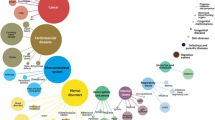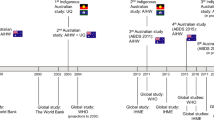Abstract
The World Bank's Global Burden of Disease Study pioneered the use of Disability Adjusted Life Years (DALYs). In this paper we distinguish between the total and the “avoidable” burden of disease. We identify different ways of measuring DALYs: incidence‐based DALYs are appropriate where the means of reducing the burden of disease is by prevention; prevalence‐based DALYs are appropriate when a disease cannot be prevented but effective treatment is available. The methods of estimating each are explained and we describe how we have applied these methods to seven causes of death and disability in the South and West Region. We discuss the relevance of this work for monitoring the health of populations and deciding how best to use scarce resources to improve health.
Similar content being viewed by others
References
S. Anand and K. Hanson, Disability adjusted life years: a critical review, Journal of Health Economics 16 (1997) 685–702.
T.V. Andersen and G. Mooney, eds., The Challenges of Medical Practice Variation (Macmillan, London, 1990).
J. Bamford, M. Dennis, P. Sandercock, J. Burn and C. Warlow, The frequency, causes and timing of death within 30 days of a first stroke, Neurosurgery and Psychiatry 53 (1990) 824–829.
M. Barry, A.G. Mulley, F.J. Fowler and J.W. Wennberg, Watchful waiting vs immediate transurethral resection for symptomatic prostatism. The importance of patients' preferences, JAMA 259 (1988) 3010–3017.
R. Bernersen, B. Johnsen, B. Straume, P.G. Burhol, T.G. Jenssen and P.A. Stakkevold, Towards a true prevalence of peptic ulcer: the Sorreisa gastrointestinal disorder study, Gut 31 (1990) 989–992.
G. Bevan and S. Hollinghurst, Discounting and age weighting in DALYs, in: The South and West DALYs Project, ed. C. Bowie (Somerset Health Authority, England, 1998).
S. Birch and C. Donaldson, Application of cost-benefit analysis to health care: departures from welfare economic theory, Journal of Health Economics 6 (1987) 211–225.
S. Birch and A. Gafni, Cost-effectiveness analyses: Do current decision rules lead us where we want to be?, Journal of Health Economics 11 (1992) 279–296.
S. Birch and A. Gafni, Changing the problem to fit the solution: Johannesson and Weinstein's (mis)application of economics to real world problems, Journal of Health Economics 12 (1993) 469–476.
C. Bowie, ed., The South and West DALYs Project (Somerset Health Authority, England, 1998).
J.P. Bunker, Medicine matters after all, Journal of the Royal College of Physicians of London 29 (1995) 105–112.
A. Coale and G. Guo, Revised regional model life tables at very low levels of mortality, Population Index 55(4) (1989) 613–643.
M.H. De Groot, Probability and Statistics, 2nd ed. (Addison-Wesley, 1986).
C. Donaldson and G. Mooney, Needs assessment, priority setting, and contracts for health care: an economic overview, British Medical Journal 303 (1991) 1529–1530.
C. Donaldson, Economics, public health and health care purchasing, Health Policy 33(2) (1995) 79–90.
J. Donovan, J. Coast and T. Peters, Treatment for Benign Prostatic Hyperplasia: A Systematic Review (HCEU, University of Bristol, Bristol, 1996).
O. Ekeberg, T.O. Klemsdal and S.E. Kjeldsen, Quality of life on enalapril after myocardial infarction, European Heart Journal 15 (1994) 1135–1139.
C. Ham, ed., Health Care Variations (King's Fund Institute, London, 1988).
J. Hirshleifer, On the theory of optimal investment decision, Journal of Political Economy 66 (1958) 329–52.
W.W. Holland, ed., European Community Atlas of 'Avoidable' Death, Vol. 1 (Oxford University Press, Oxford, 1991).
D.J.W. Hunter, C.M. McKee, N.A. Black and C.F.B. Sanderson, Urinary symptoms: prevalence and severity in British men aged 55 and over, Journal of Epidemiology and Community Health 48 (1994) 569–575.
D.A. Jones and R.R. West, Psychological rehabilitation after myocardial infarction: multicentre randomised controlled trial, British Medical Journal 313(1996) 1517–1521.
H.A. Khan, H. Leibowitz and J. Ganley, The Framingham eye study, American Journal of Epidemiology 106 (1997) 17–41.
K. McPherson, A. Downing and D. Buirski, Systematic Variation in Surgical Procedures and Hospital Admission Rates, PHP Departmental Publication No. 23, London School of Hygiene and Tropical Medicine, London (1996).
G. Mooney, Key Issues in Health Economics (Harvester Wheatsheaf, New York, 1994).
R. Moore, Helicobacter pylori and peptic ulcer: a systematic review of effectiveness and an overview of the economic benefits of implementing what is known to be effective, Pain relief research unit vii, 37, Oxford (1995).
C.J.L. Murray, Quantifying the burden of disease: the technical basis for disability-adjusted life years, Bulletin of the WHO 72 (1994) 429–445.
C. Murray and A. Acharya, Understanding DALYs, Journal of Health Economics 16 (1997) 703–730.
C.J.L. Murray and A.D. Lopez, Quantifying disability: data, methods and results, Bulletin of the WHO 72 (1994) 481–494.
C.J.L. Murray and A.D. Lopez, eds., The Global Burden of Disease (Harvard University Press, Boston, 1996).
C.J.L. Murray and A.D. Lopez, Mortality by cause for eight regions of the world: Global Burden of Disease Study, The Lancet 349 (1997) 1269–1276.
C.J.L. Murray and A.D. Lopez, Regional patterns of disability-free life expectancy: Global Burden of Disease Study, The Lancet 349 (1997) 1347–1352.
C.J.L. Murray and A.D. Lopez, Global mortality, disability, and the contribution of risk factors: Global Burden of Disease Study, The Lancet 349 (1997) 1436–1442.
C.J.L. Murray and A.D. Lopez, Alternative projections of mortality and disability by cause 1990-2020: Global Burden of Disease Study, The Lancet 349 (1997) 1498–1504.
C.J.L. Murray, Rethinking DALYs, in: The Global Burden of Disease, eds. C.J.L. Murray and A.D. Lopez (Harvard University Press, Boston, 1996).
J.N. Newton, V. Seagroatt and M. Goldacre, Geographical variation in hospital admission rates: an analysis of workload in the Oxford region, England, J. Epidemiol. Comm. Health 48 (1994) 590–595.
E. Nord, The person trade off approach to valuing health care programs, Medical Decision-Making 15(3) (1995) 201–208.
Office of Population Censuses and Surveys, ed., OPCS Surveys of Psychiatric Morbidity in Great Britain (HMSO, London, 1995).
P. Paul-Shaheen, J.D. Clark and D. Williams, Small area analysis: a review and analysis of the North American literature, J. Health Polit. Policy Law 12 (1987) 714–809.
E.S. Paykel, ed., Handbook of Affective Disorders, 2nd ed. (Churchill Livingstone, 1992).
N. Pearson, J. O'Brien, H. Thomas, P. Ewings, L. Gallier and A. Bussey, Collecting morbidity data in general practice: The Somerset Morbidity Project, British Medical Journal 312 (1996) 1517–1520.
D. Sanders, A. Coulter and K. McPherson, Variations in Hospital Admission Rates: A Review of the Literature (King Edward's Hospital Fund for London, London, 1989).
C.F. Sanderson, D.J. Hunter, C.M. McKee and N.A. Black, Limitations of epidemiologically based needs assessment. The case of prostatectomy, Medical Care 35(7) (1997) 669–685.
Secretary of State for Health, The Health of the Nation (HMSO, London, 1992).
Secretary of State for Health, Our Healthier Nation (Stationery Office, London, 1998).
A. Sonnenberg and J.E. Everhart, The prevalence of self-reported peptic ulcer in the United States, American Journal of Public Health 86 (1996) 200–205.
A. Stevens and J. Raftery, eds., Health Care Needs Assessment. The Epidemiolgically Based Needs Assessment Reviews (Radcliffe Medical Press, Oxford, 1994).
A.A. Stinnett and A.D. Paltiel, Mathematical programming for the efficient allocation of health care resources?, Journal of Health Economics 15 (1996) 641–653.
H. Tunstall-Pedoe, C. Morrison, M. Woodward, B. Fitzpatrick and G. Watt, Sex differences in myocardial infarction and coronary deaths in the Scottish Monica population of Glasgow 1989-1991, Circulation 93 (1996) 1981–1992.
A. Williams, Calculating the global burden of disease: Time for a strategic re-appraisal, Health Economics 8(1) (1999) 1–8.
M.H. Williams, S.J. Frankel, K. Nanchahal, J. Coast and J.L. Donovan, Total hip replacement, in: Health Care Needs Assessment: Epidemiologically Based Needs Assessment Reviews, Vol. 1, eds. A. Stevens and J. Raftery (Radcliffe Medical Press, pOxford, 1994).
J.K. Wing and F. Bebbington, Epidemiology of depression, in: Handbook of Depression: Treatment Assessment and Research, 2nd ed., eds. E.E. Beckham and W.R. Leber (Guildford Press, New York, 1995).
R. Woodward, S. Boyarsky and H. Barnett, Discounting surgical benefits. Enucleation versus resection of the prostate, Journal of Medical Systems 7 (1983) 481–493.
World Bank, ed., World Development Report 1993: Investing in Health (Oxford University Press, New York, 1993).
World Health Organisation, ed., World Health Statistics Annual, 1993 (WHO, 6Geneva, 1994).
Author information
Authors and Affiliations
Rights and permissions
About this article
Cite this article
Hollinghurst, S., Bevan, G. & Bowie, C. Estimating the “avoidable” burden of disease by Disability Adjusted Life Years (DALYs). Health Care Management Science 3, 9–21 (2000). https://doi.org/10.1023/A:1019016702081
Issue Date:
DOI: https://doi.org/10.1023/A:1019016702081




